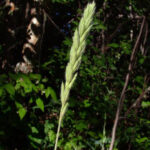Fuzzy-spiked (Hairy) Wildrye
Leymus innovatus
General Description
Fuzzy-spiked wildrye is sometimes called hairy wildrye, but is a different species than Elymus hirsutus, which is also commonly called hairy wildrye. Fuzzy-spiked wildrye is a tall, cool season, perennial tufted grass that is adapted to a wide range of soil conditions. It is sod-forming with a deep spreading root system and creeping scaly rhizomes. It is often used for native species site rehabilitation, as its rapidly spreading rhizomes are good for erosion control.
Type
Native grass.
Origin
Fuzzy-spiked wildrye is native to North America.
Longevity
Fuzzy-spiked wildrye is considered short lived (i.e., 3-8 years).
Use
Reclamation, grazing. An important native component to open forests, disturbed sites, and rangelands. It provides important winter forage for mountain sheep in the northern region.
Optimal Time of Use
Summer and fall for livestock, and winter for wildlife.
Recovery After Use
Most suited to one grazing per season.
Palatability/Nutritional Value
Only fair palatability due to its coarse rough foliage. However, recent studies suggest cattle show good gains in pastures where fuzzy-spiked wildrye is prominent.
Annual Precipitation min/max (mm)
400mm / 900mm
Drought Tolerance
High drought tolerance.
Flooding Tolerance
Some flooding tolerance (i.e., 1-2 weeks in spring).
Winter Hardiness
As native a species, it is winter hardy where it is adapted.
Soil Texture Preference
Commonly found on sandy and gravelly textured soils.
Erosion Control
Rapidly spreading rhizomes make this species useful for controlling erosion when established.
Salinity Tolerance
Moderate tolerance.
Acidity Tolerance
Moderate tolerance.
Alkalinity Tolerance
Low tolerance.
Seeds per kg
577,000 seeds/kg (261,723 seeds/lb)
Suggested Mixtures
Fuzzy-spiked wildrye can be used in mixtures with other native species where this is the objective or adapted agronomic grasses.
Ease of Establishment
Fuzzy-spiked wildrye can be hard to grow from seed as germination can be low. Apply your specific seedlots germination to any seeding rate calculations.
Competitiveness
Variable with site conditions.
Management Considerations
Can be an increaser or decreaser species, depending on the site.
BC Rangeland Seeding Manual, USDA Plants Database
Fuzzy-spiked wildrye is common in native plant communities of the Peace-Liard region, and is often found in moist to dry meadows, grassy slopes and open forests.
